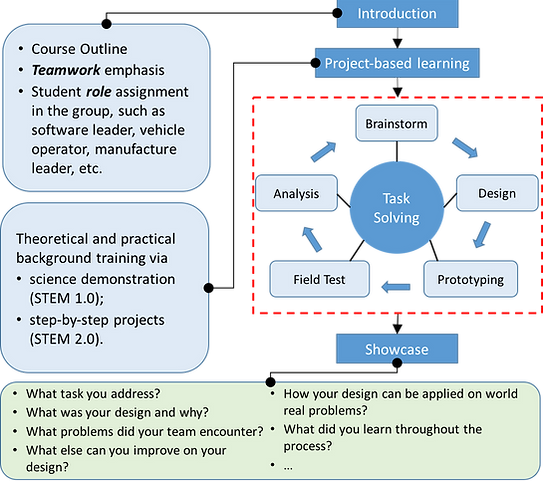STEM 3.0
After volunteering over 3 years at MIT Edgerton Center for STEM education outreach. At 2017, together with Dr. Gurvan Jodin and Dr. Ang Li, we proposed a new STEM studying and teaching concept of "STEM 3.0". It is featured with a learning style of project-and-task-based and knowledge-using role play. (The accepted abstract for IEEE EDUCON 2020 can be downloaded here.)
From 2017, "STEM 3.0" has been experimentally implemented in Shanghai with 2 newly established STEM education center and in different middle/high schools, as well as in the department of Ocean Engineering at SJTU.
Concept of STEM 3.0

Fig. 01, Concept of the “STEM 3.0” learning and teaching method and its relationship to the “Traditional”, “STEM 1.0” and “STEM 2.0” methods.

Fig. 02, Framework for the implementation of STEM 3.0 in the classroom.
With Dr. Gurvan Jodin and Dr. Ang Li, we propose a new idea of “STEM 3.0” teaching methods, which can be dated back to Prof. Harold “Doc” Edgerton’s idea (early 50s) [1] of learning via scientific principle demonstration using interactive devices (“STEM 1.0”) and Prof. Kim Vandiver’s idea (late 90s and early 00s) [2] of hands-on learning experience via a well-defined step-by-step project (“STEM 2.0”). The key elements of “STEM 3.0” teaching method is first to use interactive scientific demonstrations and step-by-step projects to prepare students with required theoretical and practical backgrounds, and then via the announcement of a given task for a simulated real-world problem to encourage them as hands-on thinkers to find their creative solutions.
Fig. 1 demonstrates the concept of the “STEM 3.0” learning and teaching method and describes its relationship with the “Traditional”, “STEM 1.0” and “STEM 2.0” methods.
Fig. 2 displays a flowchart that lists out the key steps in the framework for a successful implementation of the “STEM 3.0” method in classroom teaching.
For more detail, please refer to the paper to IEEE EDUCON 2020.
[1] Gray, P. E. (1991). Harold E. Edgerton. Physics Today, 44, 126.
[2] MIT Edgerton Center. (2014). https://edgerton-dev.mit.edu/file/dont-let-them-know-theyre-learning-0
Example: an Experimental Summer Camp for Hands-on Thinkers with "Sea Perch"
"STEM 3.0" has been implemented into tens of middle/high school and Department of Ocean Engineering, SJTU.
One of the successful example shows here is an experimental summer camp for hands-on thinker at Shanghai in 2019 summer with "Sea Perch" underwater robots (originally developed by Dr. Thomas Consi from the concept of [3]). More than 120 students attended the camp with 14 teachers, led by me.
Based on the framework of “STEM 3.0” teaching shown in Fig. 2, we divided the 6-day camp into two phases:
a. Learning the technical background with standard “Sea Perch” robot building (the first to the third day);
b. Creative problem/task solving as a hands-on thinker (the third to the sixth day).

Fig. 03, Course Structure for "Sea Perch" Robot
[3] Bohm, H., Jensen, V., & Johnston, N. (1997). Build your own underwater robot and other wet projects (Vol. 9594). Westcoast Words.

